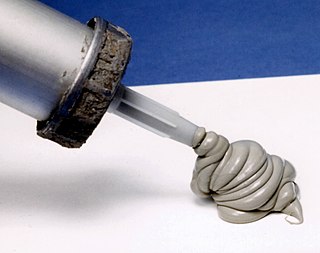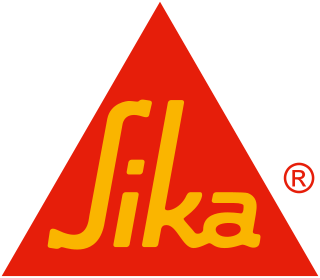
Seam sealants are chemical coating compositions.

Seam sealants are chemical coating compositions.
Seam sealants are applied to waterproof seams of items such as rainwear, tents, backpacks, shoes, drysacks, and drysuits. They are often applied by the consumer post-purchase.
Seam sealing was already performed manually successfully for preventing perforation corrosion in the 1980s. [1] Today used in the OEM automotive industry primarily for the purpose of seals against air leaks and to waterproof sheetmetal overlaps that occur in the assembly of a vehicle. Such overlaps are typically decorative rather than structurally supportive. Accordingly, they are usually only spot welded and this process results in a closure that is not air or water tight.
Seam sealants are sprayed or extruded over the joined edges of these overlaps, and they then either cure to a flexible waterproof "seal" by drying (dehydrating) in the case of water borne compositions, or thermoset irreversibly to a flexible adherent seam seal by going through an oven bake in the case of plasticized polyvinylchloride compositions. Most interior seam seals are not visible after the vehicle is finished, because they are covered by carpeting, interior roof headliner, or decorative trim panels. Exterior seam seals are always painted over and are referred to as "coach joint seals."
The flat-stream application with many special solutions (special nozzles) was increasingly used as the most flexible procedure. [2]

A silicone or polysiloxane is a polymer made up of siloxane (−R2Si−O−SiR2−, where R = organic group). They are typically colorless oils or rubber-like substances. Silicones are used in sealants, adhesives, lubricants, medicine, cooking utensils, thermal insulation, and electrical insulation. Some common forms include silicone oil, silicone grease, silicone rubber, silicone resin, and silicone caulk.

An adhesive bandage, also called a sticking plaster, medical plaster, or simply plaster in British English, is a small medical dressing used for injuries not serious enough to require a full-size bandage. They are also known by the genericized trademarks of Band-Aid or Elastoplast.

Lamination is the technique/process of manufacturing a material in multiple layers, so that the composite material achieves improved strength, stability, sound insulation, appearance, or other properties from the use of the differing materials, such as plastic. A laminate is a permanently assembled object created using heat, pressure, welding, or adhesives. Various coating machines, machine presses and calendering equipment are used.

Caulk or, less frequently, caulking is a material used to seal joints or seams against leakage in various structures and piping.

A flat roof is a roof which is almost level in contrast to the many types of sloped roofs. The slope of a roof is properly known as its pitch and flat roofs have up to approximately 10°. Flat roofs are an ancient form mostly used in arid climates and allow the roof space to be used as a living space or a living roof. Flat roofs, or "low-slope" roofs, are also commonly found on commercial buildings throughout the world. The National Roofing Contractors Association defines a low-slope roof as having a slope of 3 in 12 (1:4) or less.
A hermetic seal is any type of sealing that makes a given object airtight. The term originally applied to airtight glass containers, but as technology advanced it applied to a larger category of materials, including rubber and plastics. Hermetic seals are essential to the correct and safe functionality of many electronic and healthcare products. Used technically, it is stated in conjunction with a specific test method and conditions of use.

A heat sealer is a machine used to seal products, packaging, and other thermoplastic materials using heat. This can be with uniform thermoplastic monolayers or with materials having several layers, at least one being thermoplastic. Heat sealing can join two similar materials together or can join dissimilar materials, one of which has a thermoplastic layer.
A coating is a covering that is applied to the surface of an object, usually referred to as the substrate. The purpose of applying the coating may be decorative, functional, or both.

Heat-shrink tubing is a shrinkable plastic tube used to insulate wires, providing abrasion resistance and environmental protection for stranded and solid wire conductors, connections, joints and terminals in electrical work. It can also be used to repair the insulation on wires or to bundle them together, to protect wires or small parts from minor abrasion, and to create cable entry seals, offering environmental sealing protection. Heat-shrink tubing is ordinarily made of polyolefin, which shrinks radially when heated, to between one-half and one-sixth of its diameter.
Nitrile rubber, also known as nitrile butadiene rubber, NBR, Buna-N, and acrylonitrile butadiene rubber, is a synthetic rubber derived from acrylonitrile (ACN) and butadiene. Trade names include Perbunan, Nipol, Krynac and Europrene. This rubber is unusual in being resistant to oil, fuel, and other chemicals.

Hot-melt adhesive (HMA), also known as hot glue, is a form of thermoplastic adhesive that is commonly sold as solid cylindrical sticks of various diameters designed to be applied using a hot glue gun. The gun uses a continuous-duty heating element to melt the plastic glue, which the user pushes through the gun either with a mechanical trigger mechanism on the gun, or with direct finger pressure. The glue squeezed out of the heated nozzle is initially hot enough to burn and even blister skin. The glue is sticky when hot, and solidifies in a few seconds to one minute. Hot-melt adhesives can also be applied by dipping or spraying, and are popular with hobbyists and crafters both for affixing and as an inexpensive alternative to resin casting.
Sealant is a substance used to block the passage of fluids through the surface or joints or openings in materials, a type of mechanical seal. In building construction sealant is sometimes synonymous with caulking and also serve the purposes of blocking dust, sound and heat transmission. Sealants may be weak or strong, flexible or rigid, permanent or temporary. Sealants are not adhesives but some have adhesive qualities and are called adhesive-sealants or structural sealants.

Ducts are conduits or passages used in heating, ventilation, and air conditioning (HVAC) to deliver and remove air. The needed airflows include, for example, supply air, return air, and exhaust air. Ducts commonly also deliver ventilation air as part of the supply air. As such, air ducts are one method of ensuring acceptable indoor air quality as well as thermal comfort.
WKT is a sealing compound which was developed by Paul Pietzschke, Chemisch-Technische Fabrik, Hamburg, Germany in 1962 specifically to meet the stringent requirements in the yacht and ship building industry. WKT belongs to the silicone group of sealants.
Basement waterproofing involves techniques and materials used to prevent water from penetrating the basement of a house or a building. Waterproofing a basement that is below ground level can require the application of sealant materials, the installation of drains and sump pumps, and more.
Porosity sealing is done through the process of vacuum impregnation. Vacuum impregnation is a preferred OEM process that seals porosity and leak paths in metal castings, sintered metal parts and electrical castings that form during the casting or molding process. Vacuum impregnation stops casting porosity

Box-sealing tape, parcel tape or packing tape is a pressure-sensitive tape used for closing or sealing corrugated fiberboard boxes. It consists of a pressure-sensitive adhesive coated onto a backing material which is usually a polypropylene or polyester film which is oriented to have strength in both the long (machine) direction and the cross direction.

Sika AG is a Swiss multinational specialty chemical company that supplies to the building sector and motor vehicle industry, headquartered in Baar, Switzerland. The company develops and produces systems and products for bonding, sealing, damping, reinforcing, and protecting. Currently, it has over 25,000 employees, subsidiaries in more than 100 countries, and an annual sales turnover of CHF 8.1 billion.

A surgical sealant film is an implantable medical device used during surgery. It is a preformed flexible patch that is applied to supplement sutures and surgical staples to seal tissues and prevent leaks of fluid and air.